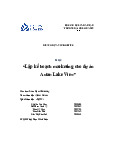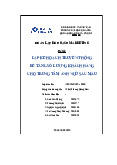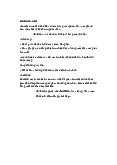

















Preview text:
Task 5-D-p.9
Complete the timeline with information from Reading 1 Your answer:
1800 – Maori is the predominant language in New Zealand
1860s –English become the dominant language of New Zealand.
1939-45: Maori was no longer the first language. Maori moved to urbans areas for works.
1970s: Many Maori people reasserted their identify.
1985: Waitangi Tribunal agreed that the government must protect the Maori language.
1987: Maori was made an official language of New Zealand.
2000s: Institutions are working to recover Maori. Task 6-G-p.11
List reasons why the Maori maintained their traditional language.Then list
reasons why the Maori learned to speak English. Write the paragraph
number in which you found the information next to each reason. Maori language English Language Traded with Maori
Needed it in the workplace or places of
Maintained their pride and identify as a
recreation such as football field. people ( Para. 3) ( Para.3)
Parents could pass on the language to
There was plenty of work available in their children ( Para. 4) towns and cities. ( Para. 5) Task 7-H-p.12:
Read the statements. Write T(true) or F(false). Then correct each false
statement to make it true. Write the number of the paragraph where you found the answer. Your answer: F
The Maori has had ups and downs since the survival of Europeans in New Zealand. (Para. 1) Your answer: F
The Maori language was discouraged to help Maori get ahead in workplace. Para 5. Your answer: T (Para 7) Your answer: F
Maori people moved to the cities during and after the Second World War because
there were more jobs available. ( Para 8) Your answer: T ( Para 10) Your answer: F
Maori needs enough fluent speakers of all ages as well as the respect and support
of the wider New Zealand community in order for it to survive as a language. Para 14. Task 8-A-p.13p.14p.15
Read the excerpts. Identify the genre of the writing. Then write the main idea in a sentence. 1.
When people move to a new culture, they usually experience a series of different
feelings as they adjust to their new surroundings. A new culture is not necessarily
another country or a place where another language is spoken. Therefore, this
adjustment can occur in any situation where a person's normal rules of behaviour
no longer work. The process of adapting to these differences has four stages and is called culture shock. Genre: Academic writing
Main idea: The process of adapting to these differences has four stages and is called culture shock
2. Solution: Say It Again Language Learning Program
The company is interested in investing in a language learning program. There are
two suitable programs available: Say It Again and Language Now. We recommend
Say It Again for these reasons: • cost - 19 percent less
• technical support - included in price
Say It Again will meet our needs at a lower cost and with better service. Genre: News articles.
Main idea: Say It Again will meet our needs at a lower cost and with better service
3. Language Researcher Faces Challenges
Dr. Wilde's research is certainly exciting. t could change the way we think about
the original inhabitants of New Zealand. But it is not without difficulty. "Of
course, the greatest challenge will be getting the local chiefs to talk to me," Wilde
admitted. "Without their cooperation, my project can't go forward." Gaining the
trust of the local population is just one of the many challenges facing Dr. Wilde in his research. Genre: Main idea:
4. Languages change through two processes: internal change and language contact.
Internal change occurs slowly over time as words or phrases shift in meaning or
grammatical structure. For instance, the Old English a nadder, meaning "a snake,"
gradually became an adder, the modern word, when the n became attached to the
article. The second source of change is external, and it occurs when another,
usually more powerful, language comes into contact with it. Genre: Main idea: 5. New Zealand in the 1830s
New Zealand was largely a Maori world in the 1830s. There were perhaps 100,000
Maori, divided into major iwi, or tribes. Relations between groups could be tense,
and conflict was common. Maori traditions and social structures prevailed, but
more Europeans arrived in New Zealand throughout the decade. There were about
200 in the North Island in the early 1830s. By 1839, there may have been 2,000
throughout the country (including around 1,400 in the North Island), attracted by trade and settlement. Genre: Main idea: Task 9-B-p.15
How would you find the main ideas in the following types of writing? Discuss
your answers with a partner. 1. an email 2. a business letter 3. an advertisement 4. a newspaper editorial Task 13-E-p.20:
Scan Reading 2 and write the correct numbers. Your answer: Your answer: Your answer: Your answer: Your answer: Task 14-G-p.21:
Write answers to these questions in your own words, using information from
Reading 2. Provide the paragraph numbers when you found the information. Your answer: Your answer: Your answer: Your answer: Your answer: Your answer: Your answer: Your answer: Task 15-A-p.24
Complete each sentence with a word from the remainder of the thesaurus
entry for knowledge. Use a different word in each sentence. Discuss your choices with a partner.
1. K. David Harrison's _______ of living with indigenous people enables him to
write persuasively about their cultures.
2. Modern medicine is turning to traditional cultures for their _______.
3. The indigenous people of Australia retain traditional _______ about the land and its history.
4. Studying textbooks is important, but this type of _______ can ignore facts that are not written down anywhere.
5. Young people are learning Maori _______ from elders to preserve their culture.
6. Writing a book or article about one's field is an example of _______.
7. One way to save the knowledge of the Bari is through _______ campaigns so
that it can be written and retained. Task 16-B-p.25
Write an appropriate synonym for each underlined word. Use your thesaurus or dictionary.
1. ___issues___________ Indigenous people in many countries have faced similar problems.
2. ______________ The shift from native languages to Spanish can be seen
across Central and South America.
3. ______________ Multiculturalism is the idea that people of different
cultures and ethnicities can live and learn together.
4. ______________ One opinion about multiculturalism is that it puts national unity in jeopardy.
5. ___announce___________ Linguists say that half of the world's languages are dying.
6. ______________ Until recently, native cultures kept knowledge by passing
it from one generation to the next.




